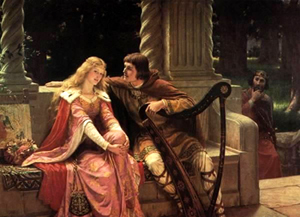
The Myth of Tristan and IsoldeBy Tala Bar
This article is based on my book Tristan and Isolde, published in Hebrew in 1984, which is the result of a research into the mythological origins and various literary presentations through the ages of the story of Tristan and Isolde.
It is advisable to read
the tale before reading the article, as well as the various links
brought here, because of lack of space for more detailed explanations.
The purpose of this article is to show the pagan mythical origins which exist at the basis of the story of Tristan and Isolde. This story has appeared in writing in practically all forms of literature from ancient times till today. As a Medieval legend, it was known as a couple of 12th century romances, and appeared in poetic form by Thomas and by Gottfried of Strasberg in the 14th century; in the 15th century it formed a part of the Arthurian legends by Sir Arthur Malory in his book La Morte d'Arthur; there is also an Icelandic balad about the death of Tristan. It was the basis for Wagner's opera of that name, and for a novel by Joseph Bedier in the 19th century, and it was the background of modern poetry in Hebrew of the 20th century, by the poet Avraham Balaban. My point in this articles is that all these different versions were initially based on a prehistorical pagan myth, which never appeared in writing, but it parallels the main elements of ancient myths from prehistoric, pre-writing, Europe and the Middle East.
To clarify, there is a need to explain the differences between the various styles of writings, in order to justify the apellation used in the title. A myth is a symbolic story using mainly divine beings as its main characters; such myth is many times used in rituals, enacting the various characters in the story as representatives of either the forces of nature, or various groups of people. A myth can be religious in purpose, it can be historical or it can present social changes.
The best known pagan myth tells the story of the Canaanite divinities Anat, Baal and Mot as they appeare in the 14th century B.C. Ugaritic scripts. The characters of the twin brothers Baal and Mot represent, respectively, the motivated spirits (i.e., gods) of the rains and liveliness of winter and the dry death of summer in the Middle Eastern area; their names mean, respectively, Lord and Death. These seasonal gods compete for the love of their sister-lover Anat, who represents the Goddess of Nature in charge of the events created by the battle between the rival gods and their cyclic dying and coming back to life in turns. In this Canaanite myth, much later than prehistorical times, the sister-lover figure of the Goddess is separate from the Mother Goddess, who is Atherat, mother of all the gods (about the nature of the Goddess see below).
A known historical myth is the story of Biblical Abraham's wanderings with his family from his place of origin in the south of Mesopotamia, via the northern part of Syria, to the Land of Canaan — thus explaining the origins and purpose of the Jewish people. Various myths presenting social changes are described by Robert Graves in his book The Greek Myths, telling of the taking over of a prehistoric Pelasgian matrilineal society in Greece by patriarchal tribes invading from Central Asia.
In contrast to symbolic myth, which is based on actual events, the legend, known sometimes more popularly as a fairytale, is a fantastic story of human characters encountering all sorts of wonderful creatures and events. Such stories use many ancient mythical themes, without actual understanding their symbolism. The romance is a special kind of legend, which deals mainly in love. From this type of legend, the word "romantic" is derived, together with the modern European word for "novel" — "roman." In the opera, there is an emphasis on emotional conflict, while modern poetry approaches every theme in a personal way.
My contention is that the story of Tristan and Isolde began its life as a myth (i.e. as a symbolic tale of real events), telling the life story of the Sun God, ritualistically enacting the yearly course of sun in the sky, under the auspices of the Goddess of Nature, who is, in turns, his mother, his lover, and his killer, when he is brought as sacrifice to her at the end of his life. Such myth is that of the Scandinavian story of Balder, the "eye of the sky", who was killed by his underworld brother-rival Hodder for the sake of the love of the Goddess Nana, who was both their mother and their lover, and for the power to rule the world.
The myth of Tristan as the Sun God, though with some Scandinavian connections,
essentially belonged to the Celtic people, who had moved in ancient
times from their original locality in the north of Italy of today's,
wandered by way of modern Spain and through the Bay of Biscay, and settled
in five distinct areas of Northwestern Europe: Bretany, Cornwall, Wells,
Ireland and Scotland. The basic myth from which the story of Tristan
and Isolde is derived is that of the Sun God born at Midwinter, who
becomes strong in Spring and marries the young representative of the
Goddess of Nature in early Summer, gets killed by his rival at Midsummer
and goes to the Underworld in autumn, from which he is born again at
Midwinter.